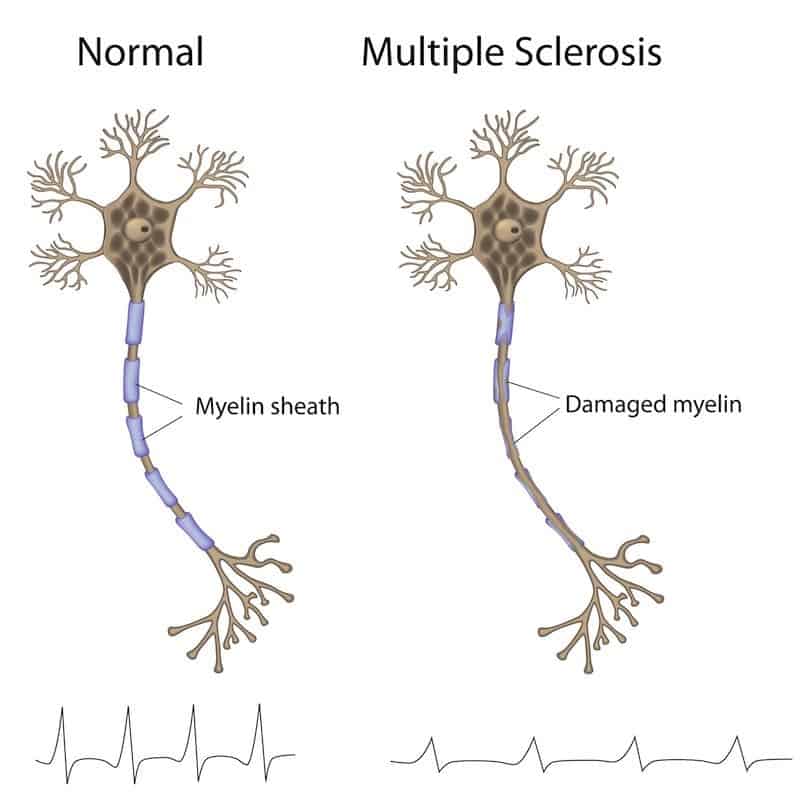For the first time, scientists have developed a treatment for Multiple Sclerosis (MS) that actually reverses the disability. Dr. Richard K. Burt performed the first hematopoietic stem cell transplant (HSCT) for a multiple sclerosis (MS) patient in the United States at Chicago’s Northwestern Memorial Hospital, and the treatment showed great promise.

MS is an inflammatory disease in which the insulating covers of nerve cells in the brain and spinal cord are damaged. This damage disrupts the ability of parts of the nervous system to communicate, resulting in a wide range of signs and symptoms, including physical, mental, and sometimes psychiatric problems. It’s not clear what causes it and there is no clear treatment for the disease.
In this trial 151 patients underwent a stem cell transplant. Their immune systems were numbed first with low dose chemotherapy, and then doctors used stem cells previously extracted from the patients to “reboot” their immune systems. After only a few days spent in the hospital, the patients then returned home, reporting no symptoms from the disease and needing no more medication.
Doctors administered several tests to detect any lingering signs of the disease and also asked participants to fill out questionnaires regarding their lives. Four years after the treatment was administered, 80 percent of participants were relapse free, and even those who relapsed showed a significant reduction of symptoms.
Since 1993, the FDA has approved 12 disease-modifying therapies (DMTs) to treat relapsing-remitting MS (RRMS). All of them basically work around suppressing the immune system, and are extremely expensive – costing some $5,000 / months. They must also be taken indefinitely, since if you stop the treatment, there is a high risk for relapse. This treatment is also very expensive – it has a one time cost of $125,000, so it only starts paying for itself after 2 years.
“If you’re doing well on first-line therapies, interferons or Copaxone, good, that’s where you should stay,” Burt added. “But if you’re having frequent relapses, two or more a year despite those therapies … I think that’s the group that, rather than going to Tysabri or Fingolimod, should be given this therapy because it’s so much more beneficial. Plus, if you wait until you’ve had all those other [DMTs] then you increase the risk of this treatment.”
However, there is still much room for improvement with this type of stem cell treatment, and with further research, it might become significantly cheaper. But there are also downsides.
“The caveat,” Burt conceded, “is this is not effective in progressive MS.” He pointed out the tendency among neurologists to try one DMT after another until the patient is out of options before offering HSCT. “But by then [the patient has] entered secondary progressive and most likely nothing will help.”
This was also an observational cohort study, not a randomized controlled study. The journal article states:
Because this is an observational cohort without a control group, inferences about causal effects of HCST cannot be made. Definitive conclusions will require a randomized trial; however, this analysis provides the rationale, appropriate patient selection, and therapeutic approach for a randomized study.
In other words, while promising, this is an initial study with many limitations. A larger, more controlled study will almost certainly lead to better results, and then we can start talking about a treatment for MS.
The team is currently conducting a larger study comparing HSCT to FDA-approved DMTs at three centers worldwide. The trial is currently enrolling, and interested patients can learn more at http://www.stemcell-immunotherapy.com/research_clinical.html.
Journal Reference: Richard K. Burt et al. Association of Nonmyeloablative Hematopoietic Stem Cell Transplantation With Neurological Disability in Patients With Relapsing-Remitting Multiple Sclerosis JAMA. 2015;313(3):275-284. doi:10.1001/jama.2014.17986.


